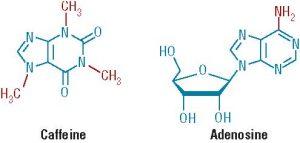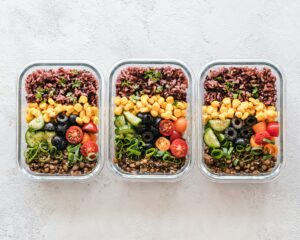Caffeine & Adenosine
As we exercise, that big spike of energy we use at the beginning, and that quickly leaves us, is called Adenosine Triphosphate (ATP). Adenosine is formed from the process of cellular respiration in the mitochondria of a cell. ATP can be drained in as little as 10 seconds. Typically, this gets done by sprinting or “going ham” on those first couple of repetitions of [you insert exercise here].

Since they both have similar profiles, caffeine binds to adenosine receptors. This blocks adenosine’s ability to slow nerve activity while increasing the body’s nerve activity and leaves us feeling stimulated, more alert, and energetic (aka, coffee jitters).
Four Agents of Caffeine
Caffeine is the most widely consumed psychoactive stimulant all over the world and is found in both cacao and coffee beans. Earl W. Sutherland, an American pharmacologist and biochemist, studied ATP and cyclic adenine monophosphate (cMAP). He won the Nobel Prize in Physiology and Medicine in 1971. Sutherland demonstrated that caffeine inhibits the breakdown of cAMP by showing ATP activates certain receptors on cell walls.
The Four Agents of Caffeine: Caffeine, Diterpenes, Chlorogenic Acids, and Niacin:
- Caffeine in the brain is a natural central nervous system (CNS) stimulant. It is a potent source of the energy mediator nitric oxide through cyclic guanosine monophosphate (cGMP) accumulation and sugar production through glycogen breakdown. Also, caffeine results in improved physical and cognitive performance during and after exercise. In the liver, acute caffeine administration impairs glucose intolerance, but increases insulin sensitivity and promotes energy metabolism.
- Dirterpenes alter lipid enzymes, contributing to increases in cholesterol and low-density lipoproteins.
- Chlorogenic acid and cinnamic acid are polyphenol antioxidants. As a group, plant polyphenols are thought to protect against cardiovascular disease and cancer.
- Niacin may modify lipids and contribute to controlling atherosclerosis, which is the buildup of fats, cholesterol, and other substances in and on artery walls.
As you can see, enjoying a cup of coffee can do more than keep you awake, as you can see consuming it can also have other key health benefits.
Let’s Talk Caffeine Content

Arabica. Robusta. Excelsa. Liberica. Those are the four major coffee beans you may come across in your local coffee shop or at home.
- Though it’s the most beloved, the Arabica bean does not have the most caffeine available compared to Robusta. Most people prefer it for its sweeter and more complex taste profile. The Arabica bean contains 1.1% caffeine by weight — this equates to 8-12 mg/g of caffeine in total. A cup of brewed 100% Arabica coffee (8 oz.) contains 85 mg of caffeine.
- If you like your coffee cheap and strong an ox, go for Robusta. While its flavor is stronger and more bitter, the Robusta bean contains 2-4.5% caffeine by weight this equates to 18-20 mg/g of caffeine in total. Unlike a cup of Arabica, a cup of brewed 100% Robusta coffee (8 oz.) contains 265mg of caffeine.
- The taste of Excelsa beans has a sweet, fruity, tart profile but its mysteriously strong and dark side keeps coffee lovers coming back. These beans are used to add complexity to the flavor profile, but when used alone they have significantly less caffeine. The Excelsa bean has 0.86 to 1.13g of caffeine in total per 100g (⅔ cup) of coffee. Meaning, that a cup of brewed 100% Excelsa coffee (8 oz.) may contain up to 70mg of caffeine.
- Besides boasting a tropical fruity to savory taste profile, Liberica coffee contains the least amount of caffeine. The use of these beans is similar to Excelsa, they are meant to be a blending additive for a more complex blend. The Excelsa bean has only 1.23g (0.04oz) of caffeine for every 100g (3.52oz) of beans. Meaning, that a cup of brewed 100% Liberica coffee (8 oz.) may contain up to 60 70mg of caffeine.
Overconsumption of Caffeine Supplementation

Marketed to the youth as bright, popular flavored brands, or as a heavy-duty energizer for adult men/women- many pre-workout supplements could pose a health risk to lots of individuals. Pre-workout blends are a mixture of ingredients that enhance energy, focus, and protein synthesis. The best way to trust your product is to look for its third-party tested label, it lets you know that the product has been filtered from banned substances that may cause adverse health effects.
The FDA has cited that the daily intake limit of caffeine should be capped at 400mg (4 or 5 cups of coffee). Any more than that could bring negative effects to one’s health. However, there are dozens of pre-workout companies that provide as much as 300mg of caffeine per serving. The concern is taking a supplement ranging from 200-300mg may not be optimal for an individual’s tolerance or metabolic efficiency. Over-consumption of caffeine may cause insomnia, jitters, seizures, increased heart rate, anxiety, stomach ache, headache, nausea, and dysphoria. The FDA also mentions that the toxicity of caffeine is achieved when an individual consumes more than 1,200mg.
![]()
So, Can I Drink Coffee During a Workout?
Coffee, unlike pre-workout supplementation, is a natural stimulant that is derived from either cacao or coffee beans. It improves physical and cognitive performance during/after exercise. When caffeine is inside your central nervous system, the stimulant binds to adenosine receptors, which increases nerve activity. The chemicals that make coffee- coffee is caffeine, diterpene, chlorogenic acids, and niacin. Although there are more than four, the major coffee beans you’ll often come across are Arabica, Robusta, Excelsa, and Liberica.







